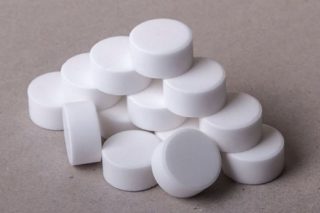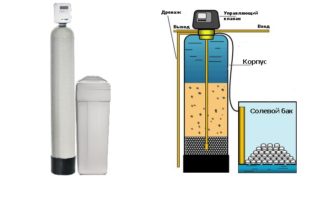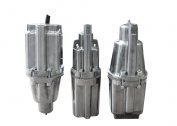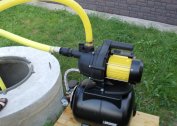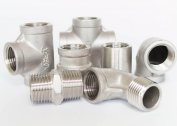Tableted salt for water treatment is used in industry and for household purposes. It is available in the form of snow-white round tablets that do not smell anything. It is made from pressed salt powder that has been purified from impurities with a sodium concentration of more than 95 percent. Salt is used to improve the quality and soften water. Filter elements with this filling can reduce the appearance of scale.
Application and varieties
It is used in filtration devices used to soften water - both industrial and domestic.
Salt preparations made in accordance with GOST have four classifications according to different characteristics:
- Production method: vacuum-cooking, stone, cage or self-planting.
- Processing method: pure and mixed with other components.
- Grinding: 0, 1, 2 and 3, as well as Extra.
- Qualitative indicator: highest, first, second grade and extra-class.
Other types of salts are not used for filtration, since they are mined like rock ore from mines. With such a mechanized method of obtaining the final product at the outlet does not have the necessary purification. High quality indicators of water treatment have tablets created by vacuum-cooking method from Extra salt without inclusions. Raw materials are extracted from wells that are dug up in salt deposits, pouring water into them. After blurring the salt layer, the brine is pumped to the surface and evaporated. After this process, a product with an ideal composition is obtained, where the concentration of sodium chloride is at least 99.7 percent. Next, the salt is granulated or tableted.
Types of salt filters and principle of operation
Tableted salt is universal, it is used in simple flow and ion-exchange filters. Both those and others are used to cleanse and soften hard water. There are filtering devices in the form of jugs, for example, the Aquaphor brand, and nozzles for spouts.
Budget options include pitcher and packed filter elements. The former are extremely simple in design. The principle of their work is the effect of gravity on water. Due to this, it passes through the filter cartridge, which leads to its cleaning.
The mixer spout is another option for an inexpensive filter device. It has compact dimensions. The principle of operation of the water purification device is to let liquid pass through, soften it and trap impurities using the built-in filter.
The stationary filtering installation of flow-accumulating action is a more expensive device for removing stiffness salts. The degree of purification is much higher in comparison with simple devices. The device is mounted on a table and connected via a flexible hose to a water tap. The unit is equipped with a reservoir where purified water is collected. It can be used for drinking after the desired volume has been processed.
The essence of the work of ion-exchange filtration elements:
- Salt in tablets is placed in a container with liquid.
- After its complete dissolution, water is sent to the resin filter, where calcium and magnesium ions are replaced by neutral sodium elements.
- The liquid is drained into the drainage network, and the resin can be used again - the volumetric index of the filtering material is being restored.
In reverse osmosis filtration systems use the salt component after the reverse osmosis process. After cleansing, the acid-base balance of the water changes. Salt tablets, which create a comfortable slightly alkaline environment, help to restore it.
For the treatment of water in filtration devices, it is advisable to use salt tablets, since they can guarantee the fastest, most uniform dissolution and the best contact with water during purification.
Replacing the fillers in the cartridges is very simple. It is enough to open the device and put in it the right amount according to the technical manual.
Criterias of choice
The quality of tableted salt must meet certain requirements:
- tablets should not be tinted;
- the size of a quality product when dissolved decreases gradually;
- The cleaner does not contain additives.
Obligatory certification for salt in tablets on the Russian territory is not necessary, and some manufacturers use this, adding cheap stone to high-quality salt. The product obtained at the outlet is inexpensive, but its quality is low. When buying such salt for economic reasons, there is a risk of reducing the operational life of filtration devices. This is especially true for filters with ion exchange resins and reverse osmosis systems.
Features of use in everyday life
In addition to softening drinking water, cleansing compounds of hardness and iron impurities, restoring the properties of ion-exchange resins, salt in tablets is often used to protect household appliances from scale: washing and dishwashers, boilers and water heaters. In a harsh environment, magnesium and potassium are the first to dissolve, and other hazardous impurities are coated with a polyphosphate-sodium film. Thanks to this, scale does not form, and the operational period of household appliances rises several times.
To add filter media, open the top cover and load the right amount of tablets. Product consumption for different filters varies; it is indicated in the accompanying documentation for the device. For example, for “dishwashers” and “washers” it ranges from 3 to 5 grams per 100 liters.
Salt is poured into simple filtering devices, which are easy to connect with your own. They are connected in front of the household appliance. So, installation of a device for a washing machine or dishwasher is performed between a ball valve or valve and the inlet of the supply hose. If the machine is connected to a separate branch of the water supply, installation is carried out before the tap.
Salt tablets are also used to purify water in the home pool - frame or inflatable. For disinfection, a chlorine generator is connected, where the salt is a reagent.
Advantages and disadvantages
Tableted salt has many advantages. The main ones include:
- slow dissolution, rather than decay into uneven pieces;
- maximum concentration of the pure NaCl component with the least inclusion of additives;
- free circulation of fluid with the use of several tablets;
- ergonomic size;
- cost savings more than double compared to the powder counterpart;
- the impossibility of caking and petrification in the tank;
- simple control of all stages of dissolution;
- non-toxicity, fire and explosion safety.
In water of equal hardness, the dissolution of the agent always occurs at a uniform rate. The output is a homogeneous saline solution, which does not need to interfere. The “thawing effect” of salt avoids the appearance of an insoluble precipitate in the salt receiver, which can disable the device or significantly reduce its life.
The main disadvantage of the method is that it is impossible to predict the results of purification of excessively contaminated water from the pipeline.There are many impurities in it. It is difficult to accurately predict the salt reaction to non-specific pollution.
Product cost
Tableted salt for water filtration is sold in bags weighing 25 kg, convenient for transportation. Its cost is determined depending on the category and manufacturer. The prices for tableted salt for filling filters of water purification systems from the Belarusian manufacturer Mozyrsol, Russian Extra, Promsalt and Aegis are about the same - about 460 rubles per bag.
The cost of the product of Western European and Eastern brands - German Supertab, Italian Vialta, Chinese Alpha Commoditles and Egyptian Secosalt - is in the range of 600-650 rubles per 25 kilograms.
The use of a filter element and salt in tablets will protect household appliances from the appearance of scale and increase its service life. High-quality softening and purification of water will allow its use for various domestic needs.
